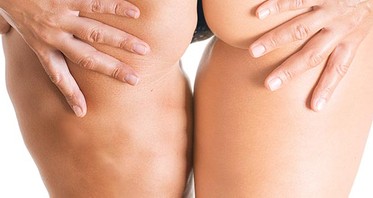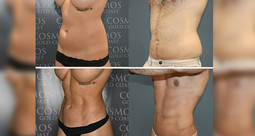Cellulite happens to women of all shapes and sizes. In fact, it’s believed between 80-90% of women will experience the condition that causes the skin to dimple and look lumpy. But what happens when you have liposuction? Does removing fat cells improve or worsen the appearance of cellulite?
Here, we share what you need to know about the liposuction procedure and cellulite so you can have realistic expectations about the cosmetic surgery.
Will liposuction treat my cellulite?
Not exactly.
Liposuction, a surgical procedure, may have a variable impact on the appearance of cellulite and should not be viewed as a definitive solution for its removal. Traditional liposuction performed on a patient who has significant cellulite coupled with poor skin elasticity and tone can actually worsen dimples and skin irregularities such as stretch marks after the fat removal.
However, Vaser Liposuction used in conjunction with cosmetic procedures such as Bio Stimulating Injections or Renuvion can help to improve the skin’s appearance and your overall body contouring results.
Cosmetic practitioners use Bio Stimulating Injections to fill in the dips and dimples of targeted areas using your own fat cells. For those with thin or slightly loose skin, Renuvion, a procedure that tightens the skin using plasma energy after the stubborn fat deposits are removed through Vaser Liposuction, may be an option.
Experienced practitioners performing these cosmetic procedures aim to enhance the appearance of the skin and endeavour to minimize potential complications like skin dimpling, although individual results and experiences may vary.
What will happen to my cellulite after liposuction?
Being a subcutaneous fat found typically on the thighs, tummy and love handles, many people believe cellulite will be treated during liposuction cosmetic surgery.
But when the excess fat is removed, isn’t the “cellulite fat” removed by the liposuction cannula too?
It’s not that simple. These superficial layers of fat are connected to the lower layers of skin by strong fibres. Essentially, cellulite isn’t an excess fat issue, more a problem occurring with the structure of the skin. Traditional liposuction techniques target the stubborn amount of fat cells rather than improving the strength and structure of the skin fibres.
The appearance of your cellulite will greatly depend on the skills of your cosmetic practitioner or liposuction experts and the liposuction techniques used. One of the undesirable side effects of traditional liposuction methods is skin irregularities like dimpling, unevenness or unwanted pockets of fat which can actually worsen the appearance of your cellulite. This is one reason why we prefer the gentler technique of Vaser Liposuction.
What will happen to my skin after liposuction?
Liposuction is an effective method to remove excess body fat and contour your shape. If a significant amount of fat is being removed during the cosmetic or plastic surgery procedure, you may experience some sagging of the skin. The liposuction procedure itself doesn’t resolve loose skin alone, but in combination with methods such as a tummy tuck or Renuvion excess skin can be addressed.
For individuals considering liposuction in areas such as the tummy or arms who have thin skin or a moderate amount of loose skin, the latest Renuvion technology should be considered alongside Vaser Liposuction.
For those who have experienced weight loss or multiple pregnancies and have cellulite along with a significant amount of sagging skin around their tummy region, a tummy tuck may be a better option.
What are effective cellulite treatments?
If you are seeking cellulite treatments alone without the need for fat removal, there are several options that can result in improvement.
- Bio Stimulating Injections that stimulate the production of new collagen to help restore tightness to saggy skin and add volume.
- Harvest Platelet Rich Plasma (PRP) is a non-invasive option that uses a high concentration of your own platelets & growth factors to help improve the skin’s texture.
- Fat injections using your own fat into the cellulite dimples to improve the appearance of cellulite and evenness of the skin.
- VaserSmooth that uses a probe to melts away noticeable superficial fat deposits.
It’s important to recognize that cellulite treatment effectiveness varies, with some individuals observing an improvement, though the extent of this can differ widely
If you’re one of many women (or men) struggling with cellulite you can be rest assured there are several options that can improve the appearance of your orange peel looking skin. Contact our team at Cosmos Aesthetics for individually tailored advice.
Related posts






